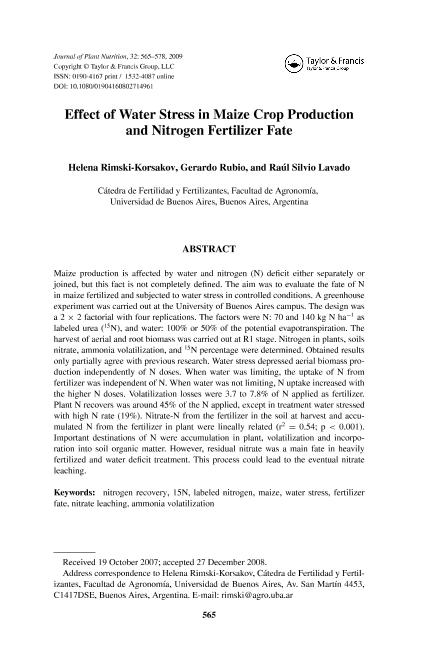Mostrar el registro sencillo del ítem
dc.contributor.author
Rimski Korsakov, Helena
dc.contributor.author
Rubio, Gerardo

dc.contributor.author
Lavado, Raul Silvio

dc.date.available
2018-09-24T20:21:54Z
dc.date.issued
2009-04
dc.identifier.citation
Rimski Korsakov, Helena; Rubio, Gerardo; Lavado, Raul Silvio; Effect of water stress in maize crop production and nitrogen fertilizer fate; Taylor ; Journal of Plant Nutrition; 32; 4; 4-2009; 565-578
dc.identifier.issn
0190-4167
dc.identifier.uri
http://hdl.handle.net/11336/60824
dc.description.abstract
Maize production is affected by water and nitrogen (N) deficit either separately or joined, but this fact is not completely defined. The aim was to evaluate the fate of N in maize fertilized and subjected to water stress in controlled conditions. A greenhouse experiment was carried out at the University of Buenos Aires campus. The design was a 2 × 2 factorial with four replications. The factors were N: 70 and 140 kg N ha-1 as labeled urea (15N), and water: 100% or 50% of the potential evapotranspiration. The harvest of aerial and root biomass was carried out at R1 stage. Nitrogen in plants, soils nitrate, ammonia volatilization, and 15N percentage were determined. Obtained results only partially agree with previous research. Water stress depressed aerial biomass production independently of N doses. When water was limiting, the uptake of N from fertilizer was independent of N. When water was not limiting, N uptake increased with the higher N doses. Volatilization losses were 3.7 to 7.8% of N applied as fertilizer. Plant N recovers was around 45% of the N applied, except in treatment water stressed with high N rate (19%). Nitrate-N from the fertilizer in the soil at harvest and accumulated N from the fertilizer in plant were lineally related (r2 = 0.54; p < 0.001). Important destinations of N were accumulation in plant, volatilization and incorporation into soil organic matter. However, residual nitrate was a main fate in heavily fertilized and water deficit treatment. This process could lead to the eventual nitrate leaching. Copyright © Taylor & Francis Group, LLC.
dc.format
application/pdf
dc.language.iso
eng
dc.publisher
Taylor

dc.rights
info:eu-repo/semantics/openAccess
dc.rights.uri
https://creativecommons.org/licenses/by-nc-sa/2.5/ar/
dc.subject
15n
dc.subject
Ammonia Volatilization
dc.subject
Fertilizer Fate
dc.subject
Labeled Nitrogen
dc.subject
Maize
dc.subject
Nitrate Leaching
dc.subject
Nitrogen Recovery
dc.subject
Water Stress
dc.subject.classification
Nutrición, Dietética

dc.subject.classification
Ciencias de la Salud

dc.subject.classification
CIENCIAS MÉDICAS Y DE LA SALUD

dc.title
Effect of water stress in maize crop production and nitrogen fertilizer fate
dc.type
info:eu-repo/semantics/article
dc.type
info:ar-repo/semantics/artículo
dc.type
info:eu-repo/semantics/publishedVersion
dc.date.updated
2018-09-21T20:35:38Z
dc.journal.volume
32
dc.journal.number
4
dc.journal.pagination
565-578
dc.journal.pais
Reino Unido

dc.journal.ciudad
Londres
dc.description.fil
Fil: Rimski Korsakov, Helena. Universidad de Buenos Aires. Facultad de Agronomía. Departamento de Ingeniería Agrícola y Uso de la Tierra. Cátedra de Fertilidad y Fertilizantes; Argentina
dc.description.fil
Fil: Rubio, Gerardo. Consejo Nacional de Investigaciones Científicas y Técnicas; Argentina. Universidad de Buenos Aires. Facultad de Agronomía. Departamento de Ingeniería Agrícola y Uso de la Tierra. Cátedra de Fertilidad y Fertilizantes; Argentina
dc.description.fil
Fil: Lavado, Raul Silvio. Consejo Nacional de Investigaciones Científicas y Técnicas; Argentina. Universidad de Buenos Aires. Facultad de Agronomía. Departamento de Ingeniería Agrícola y Uso de la Tierra. Cátedra de Fertilidad y Fertilizantes; Argentina
dc.journal.title
Journal of Plant Nutrition

dc.relation.alternativeid
info:eu-repo/semantics/altIdentifier/doi/https://dx.doi.org/10.1080/01904160802714961
dc.relation.alternativeid
info:eu-repo/semantics/altIdentifier/url/https://www.tandfonline.com/doi/abs/10.1080/01904160802714961
Archivos asociados
